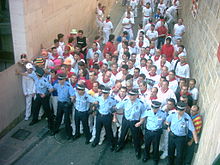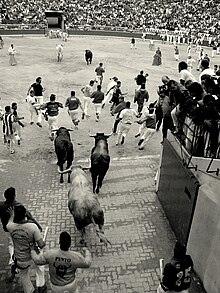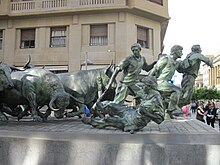Running of the bulls
| Running of the Bulls (encierro) | |
|---|---|
 The bull run in Pamplona | |
| Location(s) | Pamplona, Spain |
The Running of the Bulls (in Spanish encierro, from the verb encerrar,to fence in, to lock/shut up, to pen)[1] is a practice that involves running in front of a small group (typically a dozen) of bulls that have been let loose, on a course of a sectioned-off subset of a town's streets. The most famous running of the bulls is that of the seven-day festival of Sanfermines in honour of San Fermín in Pamplona,[2] although they are held in towns and villages across Spain, Portugal, and in some cities in Mexico,[3] Mesquite, Nevada,[4] and southern France, during the summer. Unlike bullfights, which are performed by professionals, anyone older than 18 may participate in an encierro.
The purpose of this event was in origin to transport the bulls from the off-site corrals where they had spent the night, to the bullring where they would be killed in the evening. Youngsters would jump among them to show off their bravado.
Spanish tradition says the true origin began in North-eastern Spain during the early 14th century. While transporting cattle in order to sell at the market, men would attempt to speed the process by hurrying their cattle using tactics of fear and excitement. After years of this practice, the transportation and hurrying began to turn into a competition, as young adults would attempt to race in front of the bulls and make it safely to their pens without being overtaken. When the popularity of this practice increased and was noticed more and more by the expanding population of Spanish cities, a tradition was created and stands to this day.[5]
Animal rights groups protest against the tradition.
The event

Before the running of the bulls, a set of wooden or iron barricades is erected to direct the bulls along the route and to block off side streets. There may be a double row of barricades along the route to allow runners to quickly exit in case of danger. The gaps in the barricades are wide enough for a person to slip through, but narrow enough to block a bull.
Pamplona bull run
The Pamplona[2] encierro is the most popular in Spain and is broadcast live by two national television channels.[6][7] It is the highest profile event of the San Fermin festival, which is held every year from July 6–14.[2] The first bull running is on July 7, followed by one on each of the following mornings of the festival, beginning every day at 8 am. Participants must be at least 18 years old, run in the same direction as the bulls, not incite the bulls, and not be under the influence of alcohol.[8]
Fence
In Pamplona a double wooden fence is used in those streets where there is enough space for it, while in other parts the buildings of the street act as barriers. It is composed of around three thousand separate pieces and while some parts are left for the duration of the fiesta others are mounted and dismounted every morning.[9]
Preliminaries

The encierro begins with runners singing a benediction. It is sung twice, once in Spanish and once in Basque. The Spanish version is as follows: "A San Fermín pedimos, por ser nuestro patrón, nos guíe en el encierro dándonos su bendición" ("We ask Saint Fermín, as our Patron, to guide us through the encierro and give us his blessing"). The benediction is a prayer given at a statue of Saint Fermin, patron of the festival and the city, to ask the saint's protection. The singers finish by shouting “Viva San Fermín!, Gora San Fermín!” ("Long live San Fermin", in Spanish and Basque).[8] Runners dress in the traditional clothing of the festival which consists of a white shirt and trousers with a red waistband and neckerchief. In one hand, they hold the day's newspaper rolled to draw the bulls' attention from them if necessary.[8]
The running

A first rocket is set off at 8 a.m. to alert the runners that the corral gate is open. A second rocket signals that all six bulls have been released. The third and fourth rockets are signals that all of the herd has entered the bullring and its corral respectively, marking the end of the event.[8] The average duration between the first rocket and the end of the encierro is around four minutes.[8]
The herd is composed of the six bulls to be fought in the afternoon, six steers that run with the bulls, and three more steers that leave the corral two minutes later. The function of the oxen is to guide the herd and all the days of the festival are the same.[8] The average speed of the herd is 24 km/h (15 mph).[8]
The length of the run is 826 metres (903 yards). It goes through four streets of the old part of the city (Santo Domingo, Town Hall Square, Mercaderes and Estafeta) and a section called Telefónica before entering into the bullring.[2] The fastest part of the route is up Santo Domingo and across the Town Hall Square, but in the past the bulls often became separated at the entrance to Estafeta Street as they slowed down. One or more would slip going into the turn at Estafeta, but, with the use of the new anti-slip surfacing, most of the bulls negotiate the turn onto Estafeta and are often ahead of the steers. This has resulted in a quicker, but not a safer run, as the bulls are usually ahead of the steers as they reach the lane.[citation needed] Get out tha way
Injuries and fatalities
Every year, between 200 and 300 people are injured during the run although most injuries are contusions due to falls and are not serious.[8] Since record-keeping began in 1924, 15 people have been killed in Pamplona.[8]
| Year | Name | Age | Origin | Location | Cause of death |
|---|---|---|---|---|---|
| 1924 | Esteban Domeño | 22 | Navarre, Spain | Telefónica | Goring [10] |
| 1927 | Santiago Zufía | 34 | Navarre, Spain | Bullring | Goring [10] |
| 1935 | Gonzalo Bustinduy | 29 | San Luis Potosí, Mexico | Bullring | Goring [10] |
| 1947 | Casimiro Heredia | 37 | Navarre, Spain | Estafeta | Goring [10] |
| 1947 | Julián Zabalza | 23 | Navarre, Spain | Bullring | Goring [10] |
| 1961 | Vicente Urrizola | 32 | Navarre, Spain | Santo Domingo | Goring [10] |
| 1969 | Hilario Pardo | 45 | Navarre, Spain | Santo Domingo | Goring [10] |
| 1974 | Juan Ignacio Eraso | 18 | Navarre, Spain | Telefónica | Goring [10] |
| 1975 | Gregorio Gorriz | 41 | Navarre, Spain | Bullring | Goring [10] |
| 1977 | José Joaquín Esparza | 17 | Navarre, Spain | Bullring | Suffocated in a pile-up at the entrance to the Bullring.[8] |
| 1980 | José Antonio Sánchez | 26 | Navarre, Spain | Town Hall Square | Goring [10] |
| 1980 | Vicente Risco | 29 | Badajoz, Spain | Bullring | Goring [10] |
| 1995 | Matthew Peter Tassio | 22 | Glen Ellyn, Illinois, USA | Town Hall Square | Goring[11] |
| 2003 | Fermín Etxeberria | 63 | Navarre, Spain | Mercaderes | Hit by the horn of a bull[12] |
| 2009 | Daniel Jimeno Romero | 27 | Alcalá de Henares, Spain | Telefónica | Goring[13][14] |
Other encierros have caused fatalities too, for example a woman who died in 2010 in Arganda del Rey.[15]
Media depictions

The encierro of Pamplona has been depicted many times in literature, television or advertising, but became known world wide partly due to the descriptions of Ernest Hemingway in The Sun Also Rises and Death in the Afternoon. The cinema pioneer Louis Lumière filmed the run in 1931.[16]
The run is depicted in the 1991 Billy Crystal film City Slickers where the character "Mitch" (Crystal) is gored (non-fatally) from behind by a bull during a vacation with the other main characters.
The run appears in the 2011 Bollywood movie Zindagi Na Milegi Dobara as the final dare in the bucket list where three bachelors have to overcome their ultimate fear, death. The trio run the full route. They stop at the square, but recover their nerve, and continue to the end. The friends had expressed their reservations a day earlier, saying, "You could be dangling from their horns like tandoori chicken on a s
History
The history of The Running of the Bulls is not completely clear. It started when bullfighting became a popular pastime, and many bullrings were built. The only way to get the bulls from the corral to the bullring was by running them through the streets to the ring. Eventually, people started running with the bulls, even though it was actually illegal at the time. As every year passed, this became more and more popular, and has grown into this extremely important festival.
Other examples

Although the most famous running of the bulls is that of San Fermín,[2] they are held in towns and villages across Spain, Portugal, and in some cities in southern France during the summer. Examples are the bull run of San Sebastián de los Reyes, near Madrid, at the end of August which is the most popular of Spain after Pamplona, the bull run of Cuéllar, considered as the oldest of Spain since there are documents of its existence dating back to 1215, the Highland Capeias of the Raia in Sabugal, Portugal, with horses leading the herd crossing old border passes out of Spain and using the medieval 'Forcåo', or the bull run of Navalcarnero held at night.
The English town of Stamford, Lincolnshire was host to a bull-running festival for almost 700 years until it was abandoned in 1837.[17] According to local tradition, the custom dated from the time of King John when William de Warenne, 5th Earl of Surrey, saw two bulls fighting in the meadow beneath. Some butchers came to part the combatants and one of the bulls ran into the town, causing a great uproar. The earl, mounting his horse, rode after the animal, and enjoyed the sport so much, that he gave the meadow in which the fight began, to the butchers of Stamford, on condition that they should provide a bull, to be run in the town every 13 November, for ever after.
Mock bull runs
A variation is the nightly "fire bull" where balls of flammable material are placed on the horns. Currently the bull is often replaced by a runner carrying a frame on which fireworks are placed and dodgers, usually children, run to avoid the sparks.
In 2008 Red Bull Racing driver David Coulthard and Scuderia Toro Rosso driver Sébastien Bourdais performed a version of 'bull running' event in Pamplona, Spain, with the Formula One cars chasing 500 runners through the actual Pamplona route.[18]

The Big Easy Rollergirls roller derby team has performed a version of annual bull run in New Orleans, Louisiana since 2007. In 2012 there were 14,000 runners and over 400 "bulls" from all over the country, with huge before- and after-parties.[19][20] [21]
In Ballyjamesduff, Ireland, an annual "Pig Run" is held. It looks just like encierro but with wild boars instead of bulls.
In Dewey Beach, Delaware, the Starboard bar[22] sponsors an annual Running of the Bull [sic], in which hundreds of red and white-clad beachgoers are chased down the shore by a single “bull” (two people in a costume).
In Te Kuiti, New Zealand, an annual "Running of the Sheep" is held. Where 1000-2000 sheep are released down the main street of the small farming town.
The Running of the Bulls UK is a pub crawl event that takes place on London's Hampstead Heath and uses fast runners in place of bulls.
Opposition
Many animal rights activists oppose the event. PETA activists created the "running of the nudes", a demonstration the day before the beginning of San Fermín in Pamplona. By marching naked, they protested the festival and the following bullfight, arguing the bulls are tortured for entertainment.[23]
The city of San Miguel de Allende, Mexico, cancelled its Sanmiguelada running of the bulls after 2006, citing public disorder associated with the event.[24] After the event was cancelled in San Miguel, the city of Salvatierra, also in the state of Guanajuato, picked up the event. It is now called La Marquesada and the three-day event is held during the last weekend of the month of September or first weekend of October.
See also
References
- ^ "Spanish-English Dictionary". WordReference.com. 2008. Retrieved 2008-07-21.
- ^ a b c d e "Sanfermin guide. Running of the bulls". Kukuxumusu. 2007. Retrieved 2008-07-21.
- ^ "Bull-run hits liquor-fueled town", Feb. 2, 2009. "The tradition, enacted in a handful of Mexican towns, traces its roots back to the centuries-old Pamplona bull-run in Mexico's former colonial power." Retrieved March 4, 2009.
- ^ "Running of the Bulls - Mesquite, Nevada". 2camels.com. Retrieved 2011-07-02.
- ^ Running of the Bulls 2011 Live Stream (Event Information)
- ^ "Sanfermines 2008". Cuatro. 2008 chelsea is coming on the bull. Retrieved 2008-07-21.
{{cite web}}: Check date values in:|year=(help)CS1 maint: year (link) - ^ "27 años de Sanfermines en TVE". RTVE. 2008. Retrieved 2008-07-21.
- ^ a b c d e f g h i j k "The Bull Run". Ayuntamiento de Pamplona (Council of Pamplona). Retrieved 2008-07-21.
- ^ "Encierro bullrun San Fermin festival Sanfermines tourist information on Navarre". Government of Navarre. Retrieved 2010-03-08.
- ^ a b c d e f g h i j k Terra Noticias. "La muerte de hoy es la número quince en la historia del encierro" (in Spanish). Noticias.terra.es. Retrieved 2012-07-06.
- ^ "The last person killed at Pamplona". BBC. 14 July 2005. Retrieved 10 July 2009.
...Matthew Tassio...22 years old and came from Chicago...The...bull...hit him in the abdomen, severed a main artery, sliced through his kidney and punctured his liver
- ^ "Muere el pamplonés Fermín Etxeberria, de 63 años, herido en el encierro del 8 de julio" (in Spanish). DiarioDeNavarra.es. 25 September 2003. Retrieved 10 July 2009.
- ^ "Bull gores man to death in Spain". BBC. 10 July 2009. Retrieved 10 July 2009.
The 27-year-old was gored in the neck on Friday, during the fourth bull run of the week-long San Fermin festival. Daniel Jimeno Romero, from Madrid, had emergency surgery in hospital but died of his injuries. Earlier reports had described the dead man as British....a veteran Spanish bull-runner died after a fall in 2003
- ^ "One dead in the running of the bull's in Pamplona". EncierroSanFermin.com. 10 July 2009. Retrieved 10 July 2009.
A runner died in today's running of the bulls in the northern spanish city of Pamplona, the bull running held during the famous San Fermin festivities. The man died after being gored in the neck and lung by a bull of the Jandilla ranch, named "Capuchino".The runner, Daniel Jimeno Romero from Alcalá de Henares (Madrid) was at the end of the street run
- ^ Mari Carmen López del Burgo, aged 48, from Madrid, Spain. "Muere una mujer embestida por un toro en los encierros de Arganda del Rey" (in Spanish). elpais.com. 9 September 2010. Retrieved 9 September 2010.
- ^ Encierro de toros in the Spanish-language Auñamendi Encyclopedia.
- ^ Chambers Book of Days (1864),. W. & R. Chambers ltd. 1832. 13 November entry
- ^ "Red Bull to visit Pamplona for Bull running". GPUpdate.net. GPUpdate. 11 June 2008. Retrieved 30 January 2011.
- ^ Keith I. Marszalek, NOLA.com (2007-06-24). "Big Easy Rollergirls to reinact [sic] famed bull run". Blog.nola.com. Retrieved 2011-07-02.
- ^ July 20, 2008 (2008-07-20). "San Fermín in Nueva Orleans, The Running of the Roller Girls". Laughingsquid.com. Retrieved 2011-07-02.
{{cite web}}: CS1 maint: numeric names: authors list (link) - ^ Coviello, Will. "Running of the Bulls 2012". Gambit Weekly. Retrieved 18 July 2012.
- ^ "Dewey Beach, DE". The Starboard. Retrieved 2011-07-02.
- ^ Running of the Nudes. PETA official site.
- ^ "No More Bull (Running, That Is) in San Miguel de Allende," Austin American-Statesman, May 24, 2007. Retrieved Mar. 4, 2009
External links
- Photos, videos and practical information about the running of the bulls in Pamplona
- Guide, photos and videos about The Running of The Bulls in Pamplona
- Official website for the Running of the Bulls in New Orleans, Louisiana
- A video clip from Nat Geo Adventure
- Official website for the Running of the Bulls UK
